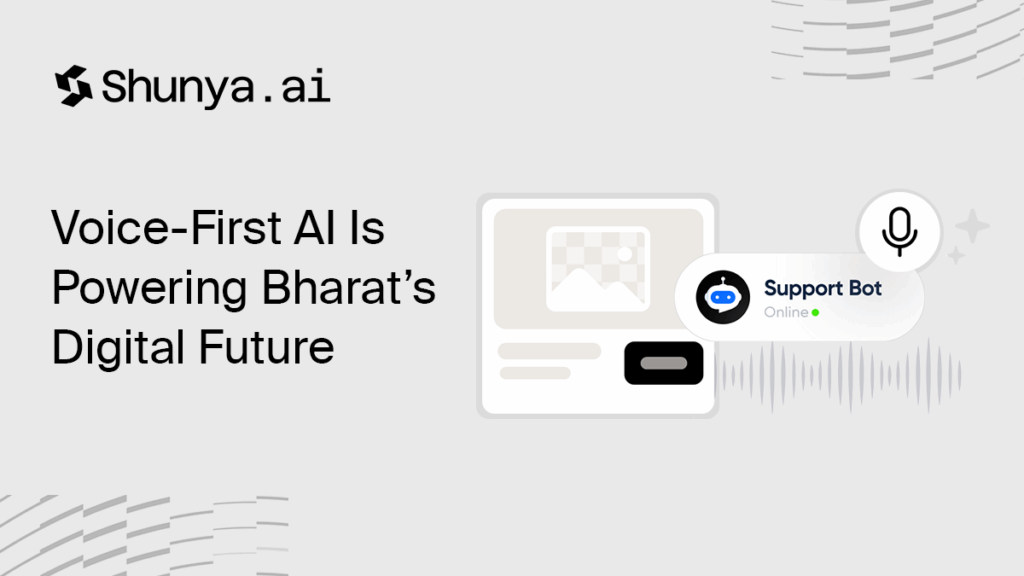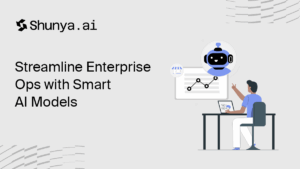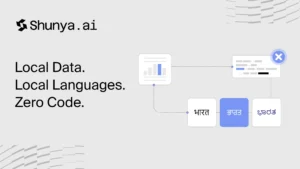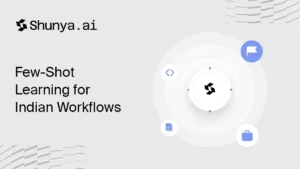| Blog Summary Voice AI is becoming the digital engine for Bharat’s growing workforce. By enabling local-language voice commands for everyday workflows, Indian enterprises can increase adoption, reduce friction and unlock scale—especially across Tier 2 and 3 cities. This is not the future. It’s already happening. |
Why Voice, Why Now?
India has over 700 million active internet users and is expected to cross 900 million by 2027—with most new users coming from non-English-speaking regions (Statista). The digital tools of the future must adapt to how people naturally interact—and for most Indians, that means voice.
From quick voice notes on WhatsApp to everyday commands to delivery partners, speech—not text—is the default mode of communication.
Voice AI for Indian enterprises leverages this behaviour to simplify work, expand access, and reduce training barriers.
What Is Voice-First AI?
Voice-first AI refers to systems that allow users to interact via spoken language rather than typing or tapping. These systems use:
- Automatic Speech Recognition (ASR)
- Natural Language Processing (NLP)
- Intent prediction
- Contextual responses
Unlike conventional chatbots, voice-first tools feel conversational, intuitive, and natural—even across different languages.
Key Capabilities
- Understands Indian languages and accents
- Executes real-time tasks using simple voice prompts
- Enables hands-free workflows for warehouse, retail and logistics staff
- Responds in natural language—no scripts needed
Why It Matters for Indian Enterprises
1. Deepens Reach Across Bharat
Most of Bharat doesn’t operate in English. Voice AI breaks the language and literacy barrier. A field sales rep in Gaya or a warehouse manager in Coimbatore can now access digital systems without typing a word.
Use case: Shipment tracking via “Mera order kaha hai?” works instantly.
2. Boosts Efficiency Across Teams
Typing is slow. Clicking through panels takes time. Voice cuts through all of that.
- Retailers update inventory with one command
- Logistics agents check delivery ETAs on the move
- Support teams close tickets with speech-to-action bots
Study: Voice interfaces are up to 3x faster than typing (Stanford HCI Group).
3. Reduces Training Costs
No manuals, no walkthroughs. Most people already know how to speak. Voice AI lets new users start instantly—saving onboarding time and effort.
Where It’s Already Working
| Sector | Voice Use Case | Outcome |
|---|---|---|
| E-commerce | Return requests, order tracking | 30% faster resolution |
| BFSI | Loan eligibility checks, account queries | 50% fewer inbound calls |
| Logistics | Shipment status, delay updates | 20% more on-time deliveries |
| Retail | Stock checks, price lookups | Reduced downtime |
| Agri-tech | Localised voice-based advice | High rural tech adoption |
Voice AI vs Traditional Chatbots
| Feature | Voice AI | Chatbot (Text-based) |
|---|---|---|
| Input method | Spoken commands | Typed text |
| User base fit | Non-English speakers, blue-collar ops | Digitally fluent users |
| Language support | Multilingual, Hinglish, code-switched | Often English or Hindi only |
| Speed of use | Up to 3x faster | Moderate |
| Ideal for | Warehouses, call centres, field ops | Customer queries, onboarding |
Building Bharat-Ready Voice Systems
Voice AI works best when designed for real-world India:
- Accent training: Handles Hinglish and regional pronunciations
- Language coverage: Supports 11+ Indian languages
- Offline readiness: Performs basic tasks even with patchy connectivity
- Smart intent recognition: Understands voice commands like “order return karna hai” or “kal ka invoice bhejna”
At Shunya.ai, we’ve trained our stack with real-world Indian voice samples and operational data—optimised for MSMEs, D2C brands and fast-scaling teams across Bharat.
Check out how no-code AI tools are enabling MSMEs in India.
Common Hurdles—and How to Overcome Them
1. Background Noise
Warehouses and shops are loud. Train models with real-world ambient sound to improve accuracy.
2. Accent and Dialect Diversity
India is linguistically complex. AI models must be tuned to local data—textbook Hindi won’t cut it.
3. Connectivity
Offline voice commands for high-frequency workflows reduce dependence on data signals.
Voice AI in Daily Workflows
Here’s what Voice AI looks like in action:
- “Show last 5 shipments from warehouse 1”
- “Track this order: 8752”
- “Update COD status to received”
- “Send payout summary to my email”
No clicks. No searching. Just voice.
Getting Started with Voice AI
- Identify common tasks—order lookup, delivery ETAs, support replies
- Test a pilot—in logistics, support or inventory
- Use multilingual training data
- Measure success—in time saved or accuracy
- Scale—to other functions and languages
Conclusion
India’s digital future will not be built by keyboards alone. It will be spoken into existence.
From kirana shops to enterprise supply chains, voice AI enables speed, simplicity and scale—especially for the next 500 million users. And the tools are ready.
Voice AI for Indian enterprises isn’t just a technological upgrade. It’s a shift in how Bharat works, builds and grows.
Ready to Bring Voice to Your Workflows?
Start building your voice-first stack with Shunya.ai—made for Bharat, trained for India.
Voice AI allows users to interact with systems via speech. For Indian enterprises, it enables multilingual access, reduces friction, and boosts efficiency across field, retail, and logistics teams.
Not at all. In fact, MSMEs and small retailers benefit the most—since voice tools reduce training costs and work without complex interfaces.
Yes. Platforms like Shunya.ai support Hindi, Bengali, Tamil, Telugu, Marathi and more—with support for localised accents and dialects.
With the right noise cancellation and training models, voice AI works well in moderately noisy environments like shops and warehouses.
Start small—pick one or two frequent workflows. Test voice input with a small group. Expand gradually as confidence and usage increase.



